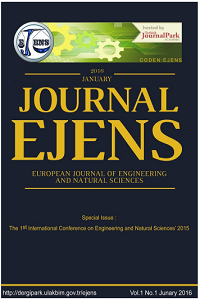First Order Integral Sliding Mode Control Of The Magnetically Levitated 4-Pole Type Hybrid Electromagnet
First Order Integral Sliding Mode Control Of The Magnetically Levitated 4-Pole Type Hybrid Electromagnet
___
- [1]. Y. Yakushi, T. Koseki and S. Sone, "3 degree-of-freedom zero power magnetic levitation control by a 4-pole type electromagnet", International Power Electronics Conference,vol.4, pp.2136-2141, April 3-7, 2000, Tokyo, Japan.
- [2]. J. Liu, T. Koseki ,“Robust Control of a 4-Pole Electromagnet in Semi-Zero-Power Levitation Scheme with a Disturbance Observer” The Transactions of I.E.E. Japan, A Publication of Industry Applications Society Vol. 122-D, No. 1, pp. 7-15, January 2002
- [3]. K. Erkan, B. Okur, T. Koseki, and F. Yigit, “Experimental evaluation of zero-power levitation control by transfer function approach for a 4-pole hybrid electromagnet,” 2011 IEEE International Conference on Mechatronics, pp. 23–28, Apr. 2011.
- [4]. Vadim Utkin, Juergen Guldner, Jingxin Shi, Sliding Mode Control in Electro-Mechanical Systems, Second Edition, CRC Press, 2009.
- [5]. Katsuhiko Ogata, Modern Control Engineering, 5th Edition, Prentice Hall, 2009.
- [6]. Shtessel, Y., Edwards, C., Fridman L., Levant A., “Sliding Mode Control and Observation (Control Engineering)”,2013th Edition
- [7]. J.-H. Lee, P. E. Allaire, G. Tao, and X. Zhang, “Integral sliding-mode control of a magnetically suspended balance beam: analysis, simulation, and experiment,” IEEE/ASME Transactions on Mechatronics, vol. 6, no. 3, pp. 338–346, 2001.
- [8]. Lee, J.-H., “A Design of Integral Sliding Mode Suspension Controller to Reject the Disturbance Force Acting on the Suspension System in the Magnetically Levitated Train System” , Transactions of the Korean Society for Noise and Vibration Engineering, Volume 17, Issue 12 2007, pp.1152-1160
- [9]. Zhen Gang Sun; Cheung N.C; Shi Wei Zhao; Wai-Chuen Gan, Integral sliding mode control with integral switching gain for magnetic levitation apparatus, 2009. PESA 2009. 3rd International Conference on Power Electronics Systems and Applications, 2009.
- [10]. Manabe, S.“Coefficient diagram method”, 14th IFAC Symposium on Automatic Control in Aerospace, Aug. 24-28, 1998, Seoul, Korea, 199- 210. (1998).
- Başlangıç: 2015
- Yayıncı: CNR Çevre
Determination of Priority Contamination Factors in Lake of Manyas (Bird Paradise)
PSIM Simulation of Flyback Converter for P&O and IC MPPT Algorithms
Isotherm and Kinetic Modelling of Azo Dyes Adsorption
Biodiesel Production Using Wet and Dry Purification Methods
Nonlinear Buckling Analysis of Cold-Formed Channel Sections
Chemically Color Removal from Textile Wastewater with Oxidizing and Reducing Agents
Mustafa KARABOYACI, Mesut UYSAL, Aziz ŞENCAN, Mehmet KILIÇ
